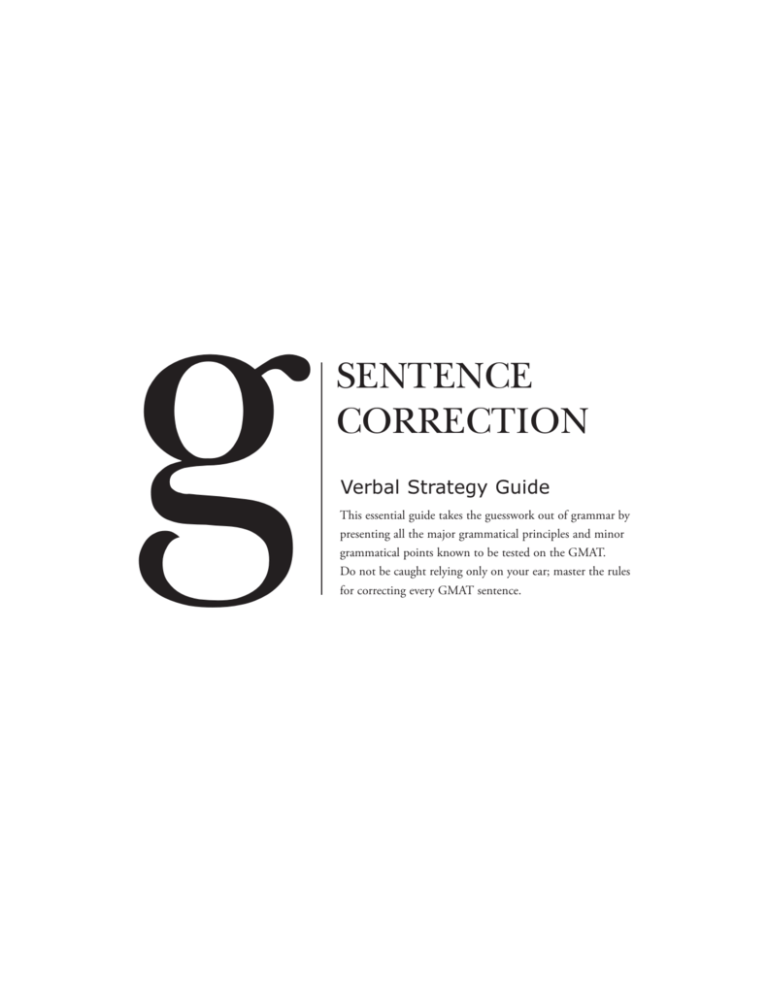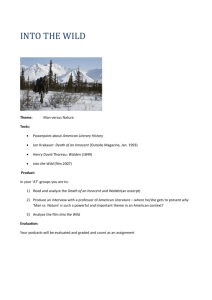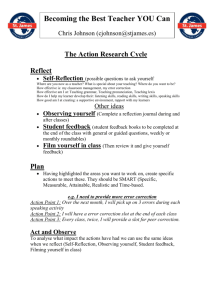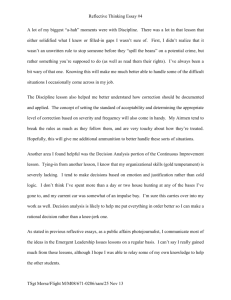
g
SENTENCE
CORRECTION
Verbal Strategy Guide
This essential guide takes the guesswork out of grammar by
presenting all the major grammatical principles and minor
grammatical points known to be tested on the GMAT.
Do not be caught relying only on your ear; master the rules
for correcting every GMAT sentence.
Sentence Correction GMAT Strategy Guide, Fourth Edition
10-digit International Standard Book Number: 0-9824238-6-1
13-digit International Standard Book Number: 978-0-9824238-6-8
Copyright © 2009 MG Prep, Inc.
ALL RIGHTS RESERVED. No part of this work may be reproduced or used in any
form or by any means—graphic, electronic, or mechanical, including photocopying,
recording, taping, Web distribution—without the prior written permission of the
publisher, MG Prep Inc.
Note: GMAT, Graduate Management Admission Test, Graduate Management
Admission Council, and GMAC are all registered trademarks of the Graduate
Management Admission Council which neither sponsors nor is affiliated in any way
with this product.
8 GUIDE INSTRUCTIONAL SERIES
g
Math GMAT Strategy Guides
Number Properties (ISBN: 978-0-9824238-4-4)
Fractions, Decimals, & Percents (ISBN: 978-0-9824238-2-0)
Equations, Inequalities, & VICs (ISBN: 978-0-9824238-1-3)
Word Translations (ISBN: 978-0-9824238-7-5)
Geometry (ISBN: 978-0-9824238-3-7)
Verbal GMAT Strategy Guides
Critical Reasoning (ISBN: 978-0-9824238-0-6)
Reading Comprehension (ISBN: 978-0-9824238-5-1)
Sentence Correction (ISBN: 978-0-9824238-6-8)
May 1st, 2009
Dear Student,
Thank you for picking up one of the ManhattanGMAT Strategy Guides—we hope that this book refreshes
your memory of the grammar that you learned a long time ago. Maybe it will even teach you a new thing
or two.
As with most accomplishments, there were many people involved in the various iterations of the book that
you’re holding. First and foremost is Zeke Vanderhoek, the founder of ManhattanGMAT. Zeke was a lone
tutor in New York when he started the Company in 2000. Now, nine years later, MGMAT has Instructors
and offices nationwide, and the Company contributes to the studies and successes of thousands of students
each year.
Our 4th Edition Strategy Guides are based on the continuing experiences of our Instructors and our students. We owe much of these latest editions to the insight provided by our students. On the Company
side, we are indebted to many of our Instructors, including but not limited to Josh Braslow, Dan Gonzalez,
Mike Kim, Stacey Koprince, Ben Ku, Jadran Lee, David Mahler, Ron Purewal, Tate Shafer, Emily Sledge,
and of course Chris Ryan, the Company’s Lead Instructor and Director of Curriculum Development.
At ManhattanGMAT, we continually aspire to provide the best Instructors and resources possible. We hope
that you’ll find our dedication manifest in this book. If you have any comments or questions, please e-mail
me at andrew.yang@manhattangmat.com. I’ll be sure that your comments reach Chris and the rest of the
team—and I’ll read them too.
Best of luck in preparing for the GMAT!
Sincerely,
Andrew Yang
Chief Executive Officer
Manhattan GMAT
www.manhattangmat.com 138 West 25th St., 9th Floor NY, NY 10001 Tel: 212-721-7400 Fax: 646-514-7425
5
*
ManhattanGMAT Prep
the new standard
1. SENTENCE CORRECTION BASICS
11
2. GRAMMAR, MEANING, CONCISION
17
In Action Problems & Solutions
Official Guide Problem Set
25
31
3. SUBJECT–VERB AGREEMENT
33
In Action Problems & Solutions
Official Guide Problem Set
45
49
4. PARALLELISM
In Action Problems & Solutions
Official Guide Problem Set
5. PRONOUNS
In Action Problems & Solutions
Official Guide Problem Set
6. MODIFIERS
In Action Problems & Solutions
Official Guide Problem Set
7. VERB TENSE, MOOD, & VOICE
In Action Problems & Solutions
Official Guide Problem Set
8. COMPARISONS
In Action Problems & Solutions
Official Guide Problem Set
9. IDIOMS
In Action Problems & Solutions
Official Guide Problem Set
10. ODDS & ENDS
In Action Problems & Solutions
Official Guide Problem Set
51
59
63
65
73
79
PART I:
GENERAL
81
93
101
103
117
123
125
131
137
139
173
183
185
197
203
TABLE OF CONTENTS
g
*
ManhattanGMAT Prep
the new standard
11. GMC/S–V/PARALLELISM: ADVANCED
In Action Problems & Solutions
Official Guide Problem Set
205
217
225
12. PRONOUNS & MODIFIERS: ADVANCED 227
In Action Problems & Solutions
Official Guide Problem Set
13. VERBS & COMPARISONS: ADVANCED
In Action Problems & Solutions
Official Guide Problem Set
14. OFFICIAL GUIDE LIST & MATRIX
Problem List
Problem Matrix
APPENDIX: GLOSSARY
239
245
247
259
267
269
271
273
289
PART II:
ADVANCED
TABLE OF CONTENTS
g
PART I: GENERAL
This part of the book covers both basic and intermediate topics within Sentence
Correction. Complete Part I before moving on to Part II: Advanced.
g
Chapter
1
of
SENTENCE CORRECTION
SENTENCE
CORRECTION
BASICS
In This Chapter . . .
g
• Question Format
• “Best” Does Not Mean Ideal
• Splits and Re-Splits
• Reading the Entire Sentence
SENTENCE CORRECTION BASICS STRATEGY
Chapter 1
SENTENCE CORRECTION BASICS
Sentence Correction is one of three question types found in the verbal section of the
GMAT. Sentence Correction tests mastery of the rules of formal written English. If you
master the rules, you can make significant gains in your performance on this question type.
Question Format
The format of a Sentence Correction question is extremely consistent. Read through the
sample question below:
Although William Pereira first gained national recognition for his movie set
designs, including those for the 1942 film “Reap the Wild Wind,” future generations remember him as the architect of the Transamerica Tower, the Malibu
campus of Pepperdine University, and the city of Irvine.
(A) including those for the 1942 film “Reap the Wild Wind,” future generations
(B) like that for the 1942 film “Reap the Wild Wind,” future generations will
(C) like those for the 1942 film “Reap the Wild Wind,” future generations
(D) including that for the 1942 film “Reap the Wild Wind,” future generations
will
(E) including those for the 1942 film “Reap the Wild Wind,” future generations
will
Do not rewrite the sentence in your own words!
You must choose the best
answer choice from
among those available.
The question consists of a given sentence, part of which is underlined. As in the example
above, the underlined segment may be only a small part of the entire sentence. However, the
underlined segment may include most or even all of the original sentence. The five answer
choices are possible replacements for the underlined segment (if the entire sentence is
underlined, each of the answer choices will be a complete sentence). If you look closely at
the example above, you may notice something about answer choice (A). In the example
above, and in all Sentence Correction questions, choice (A) is exactly the same as the
underlined portion of the sentence above it. The other choices, however, offer different
options. The question you are answering in Sentence Correction is always the same: which
of the answer choices, when placed in the given sentence, is the best option of those
given, in terms of grammar, meaning and concision (all of which will be discussed in
depth in later chapters). By the way, answer choice (A) is not always wrong. The original
sentence, (A), is the correct answer just as often as the other answer choices—about 20% of
the time.
“Best” Does Not Mean Ideal
It is very important to recognize that Sentence Correction questions ask for the best option
of those given, not the best option in the universe. Indeed, often you will feel—and rightly
so—that all the answers, including the correct one, “sound bad.” Correct GMAT Sentence
Correction answers can sound very formal or awkward, so it is important to keep in mind
that your task is to evaluate the given answer choices, not to create the ideal sentence.
The ideal sentence often is not an option, and the right answer may sound rather wrong. To
complicate matters, incorrect answer choices often sound right. Indeed, the GMAT exploits
the fact that the English we hear is commonly riddled with grammatical mistakes.
*
ManhattanGMAT Prep
the new standard
13
Chapter 1
SENTENCE CORRECTION BASICS STRATEGY
Splits and Re-Splits
If you have not already chosen an answer for the sample question, go ahead and do so now:
Although William Pereira first gained national recognition for his movie set
designs, including those for the 1942 film “Reap the Wild Wind,” future generations remember him as the architect of the Transamerica Tower, the Malibu
campus of Pepperdine University, and the city of Irvine.
Usually, the easiest splits
to spot are at the beginning or end of the
answer choices.
(A) including those for the 1942 film “Reap the Wild Wind,” future generations
(B) like that for the 1942 film “Reap the Wild Wind,” future generations will
(C) like those for the 1942 film “Reap the Wild Wind,” future generations
(D) including that for the 1942 film “Reap the Wild Wind,” future generations
will
(E) including those for the 1942 film “Reap the Wild Wind,” future generations
will
Now, how did you solve this question? Did you read the full sentence and then compare the
answer choices by re-reading the sentence with each of the possible answers? That is a very
common strategy, but it is one that you cannot afford. In order to complete the entire
Verbal section, including the many time-consuming Reading Comprehension and Critical
Reading questions, you should take no more than 90 seconds on average to answer a
Sentence Correction question. In fact, consider setting your goal to 1 minute per Sentence
Correction question.
The key to answering Sentence Correction questions within this time frame is to split the
answer choices after you have read the given sentence. Follow these steps:
1. Write down “A B C D E” on your paper (or yellow tablet if you are taking the
actual test). It does not matter if you write this horizontally or vertically.
2. Read the sentence, noting any obvious errors as you read.
3. Scan the answer choices vertically—do not read them—looking for differences that split
the answer choices. For example, in the sample question above, you can split the answers
between those that begin with including and those that begin with like. Similarly, at the end
of the answers, there is a split between those with will and those without will (essentially a
split between the present and the future tense of remember). Ideal splits will divide the
answer choices into a 2–3 split (two choices with one option, three with the other).
Sometimes you will find a three-way split (for example, another problem might have have
lifted, lifted and have been lifted among the answer choices). A three-way split is useful as
long as you can eliminate at least one of the options. If you identify a split that distinguishes only one answer choice from the others (a 1–4 split) and you eliminate the choice represented by only one answer choice, you will end up eliminating only that one answer. Thus,
1–4 splits are less useful than other kinds of splits, though they should still be considered.
4. Choose a split for which you know the grammatical rule and which side of the split is
correct. Sometimes you find a split, but you do not know which side is correct. In this case,
maybe you did not yet master the relevant rule. Alternatively, the split might be a “red herring
split,” meaning that both sides of the split are grammatically correct.
*
ManhattanGMAT Prep
14
the new standard
SENTENCE CORRECTION BASICS STRATEGY
Chapter 1
5. On your paper, cross out the answer choices that include the incorrect side of the split.
6. Compare the remaining answer choices by re-splitting. Continue to find differences in
the answers, but make sure you use only the answer choices that remain from your initial
split.
7. Continue to split remaining choices until you have one answer left.
Splitting and Re-Splitting is the foundation of the Manhattan GMAT approach to Sentence
Correction questions, so it is worth walking through the process with our sample question:
Although William Pereira first gained national recognition for his movie set
designs, including those for the 1942 film “Reap the Wild Wind,” future generations remember him as the architect of the Transamerica Tower, the Malibu
campus of Pepperdine University, and the city of Irvine.
(A) including those for the 1942 film “Reap the Wild Wind,” future generations
(B) like that for the 1942 film “Reap the Wild Wind,” future generations will
(C) like those for the 1942 film “Reap the Wild Wind,” future generations
(D) including that for the 1942 film “Reap the Wild Wind,” future generations
will
(E) including those for the 1942 film “Reap the Wild Wind,” future generations
will
Most Sentence
Correction problems test
multiple issues of grammar and style. During
the exam, you need only
one path to the right
answer.
After reading the sentence and scanning the answer choices, you may notice that the answer
choices have a 3–2 split between including and like. Let us assume that we do not know the
rule for this issue (or whether it is a red herring split); another split needs to be found.
Fortunately, there is another 3–2 split at the end of the answers: will remember versus
remember. The rule for this split is clear. Since the subject of that verb is future generations,
any action assigned to those generations, including remembering, must be in the future
tense. Therefore, answer choices (A) and (C) can be eliminated.
Next, as we compare (B), (D) and (E), we find a split between those and that. Since the
word that or those refers to movie set designs, a plural noun, it is incorrect to use the singular
pronoun that. We must use the plural pronoun those. Therefore answers (B) and (D) can be
eliminated, leaving us with the correct answer, (E).
In fact, we could have split the answer choices using including versus like. According to the
GMAT, like cannot introduce examples (such as must be used instead). Since the underlined
segment begins with an example of a set that William Pereira designed, answer choices (B)
and (C) can be eliminated. Using like alters the meaning of the sentence, suggesting that
William Pereira’s designs were simply similar to the designs for “Reap the Wind.”
If it seems daunting to master every rule of the English language tested by the GMAT, it
may be comforting to know that, as we saw in the sample question above, most Sentence
Correction questions test several different rules at once. Therefore, most answer choices can
be eliminated for multiple reasons. During your review, you should master all the rules tested by a particular problem, but on test day, you only need to find one way to the right
answer. Moreover, the GMAT tests only a finite number of grammatical principles, all of
which are discussed in the following chapters.
*
ManhattanGMAT Prep
the new standard
15
Chapter 1
SENTENCE CORRECTION BASICS STRATEGY
Reading the Entire Sentence
Using Splits and Re-Splits focuses your attention appropriately on the answer choices, so
that you avoid repeatedly (and inefficiently) re-reading the given sentence with each possible
answer inserted. However, you must begin by reading the entire sentence. For example, consider this underlined part of a sentence:
and so was unable to go to recess
You cannot decide whether this version is correct until you see the sentence in its entirety:
The students came to school without their mittens and so was unable to go to
recess.
Make sure that the
answer you choose works
in the sentence as a
whole.
If you somehow completely ignore the non-underlined section of the sentence, you cannot
know that the use of was is incorrect. (The subject of the verb was is students, a plural noun,
so the verb should be were.)
The example above is elementary, but as you encounter more Sentence Correction questions, you will see that the relationship between the underlined and non-underlined parts of
the sentence is both complex and crucial. Without understanding that relationship, you will
miss errors and perhaps choose the wrong answer. Always read the entire sentence, as the
GMAT often places important words far from the underlined portion. In fact, after you
have made your choice, you should double-check that your answer works in the context of
the entire sentence.
*
ManhattanGMAT Prep
16
the new standard
IN ACTION
GRAMMAR, MEANING, CONCISION PROBLEM SET
Chapter 2
Problem Set
A.
Meaning
The underlined portion of each sentence below may contain one or more errors. Each sentence is
followed by a boldface sample answer choice that changes the meaning of the original sentence.
Select (A) if the original version is correct, (B) if the boldface version is correct, and (C) if neither
is correct.
If you select (A), explain what is wrong with the boldface version. If you select (B), explain how the
boldface version corrects the original version. (Remember that in Sentence Correction a change of
meaning is ONLY justified if the meaning of the original sentence is illogical or unclear.) If you
select (C), explain why both versions are incorrect. Note: several of these questions refer to rules
and distinctions that will be discussed further in upcoming chapters.
1.
No matter how much work it may require, getting an MBA turns out to be a wise
investment for most people.
Even though it requires much work
2.
The driver took the people for a ride who had been waiting.
the people who had been waiting for a ride
3.
Rising costs to raw materials may impel us to rise prices farther.
costs of raw materials may impale us to raise prices further
4.
She is the most dedicated gardener on the block, every day watering the more than 50
plants in her yard.
every day watering more than the 50 plants in her yard
5.
Hector remembers San Francisco as it was when he left ten years ago.
as though he had left ten years ago
6.
Students at Carver High School are encouraged to pursue extracurricular activities like
student government, sports, and the arts.
activities such as student government, sports, and the arts
B.
Concision
Rewrite each of the following sentences more concisely. Justify the changes you make.
7.
After the fact that the test format was changed, scores subsequently dropped by more
than a 25% decrease.
8.
Electronic devices can constitute a distraction to a driver.
9.
It is possible that the earthquake may have been causal to the building’s collapse.
*
ManhattanGMAT Prep
the new standard
25
IN ACTION ANSWER KEY
A.
GRAMMAR, MEANING, CONCISION SOLUTIONS
Chapter 2
Meaning
1.
(A). The original sentence does not say that getting an MBA requires a lot of work. The expression
no matter how much work it may require simply says that the amount of work (whether large or small) does
not matter. The revised version eliminates the word may, so that the new sentence does say that an MBA
requires a lot of work. This change of meaning is UNJUSTIFIED.
2.
(C). In the original sentence, the modifier who had been waiting does not clearly modify the people.
It appears, illogically, to modify the closer noun (the ride). The boldface version moves who had been waiting next to the people, thus making clear that it is the people who had been waiting. This change of meaning
is JUSTIFIED.
However, the boldface version also makes another change of meaning. The words for a ride now come right
after waiting, so it seems that these people had been waiting for a ride. This change of meaning is
UNJUSTIFIED.
3.
(C). The boldface version makes several changes to the meaning of the original sentence. Most of
these changes are justified, but one of them is not—so the answer has to be (C).
The switch from cost to to costs of is JUSTIFIED. Costs to X are what X has to pay, whereas costs of X are
how much somebody must pay to buy X. The latter meaning makes much more sense here, because raw
materials are being paid for, not doing the paying.
The switch from impel to impale is UNJUSTIFIED. To impel is to force someone to do something. To
impale something is to pierce it with a sharp instrument!
The switch from rise to raise is JUSTIFIED. Raise is a verb that always takes a direct object: The Fed (subject) raised the interest rate (object) in March. Rise is used only in contexts where there is no direct object:
Interest rates (subject) rose in March. In our sentence, prices are a direct object, so the verb must be raise.
The switch from farther to further is JUSTIFIED. Farther refers only to distance (I can throw a javelin
farther than you can) whereas further refers to degree of something other than distance (We need further time
and money for this project).
4.
(A). The original version contains the phrase the more than 50 plants. Here the words more than
modify the number 50. The sentence therefore means that she waters her plants, of which there are more
than fifty. In the boldface version, we have the phrase watering more than the 50 plants. Here the words
more than are separated from the number 50, and therefore do not modify that number. The new version
tells us that she waters something more than (i.e., in addition to) the plants – for instance, she might water
her gravel walkway or her garden gnomes. This change of meaning is UNJUSTIFIED because there was
nothing wrong with the original sentence.
5.
(A). The boldface version makes two UNJUSTIFIED changes to the original version.
The original sentence tells us that Hector actually DID leave San Francisco ten years ago. The revised version tells as that he did NOT leave San Francisco ten years ago: the expression as though is used to discuss
things that are untrue or did not happen (You behave as though you were richer than Bill Gates!).
Another important change in meaning comes because the revised version takes out the words it (i.e., San
Francisco) was, and therefore does not refer directly to the state of affairs in San Francisco ten years ago.
*
ManhattanGMAT Prep
the new standard
27









